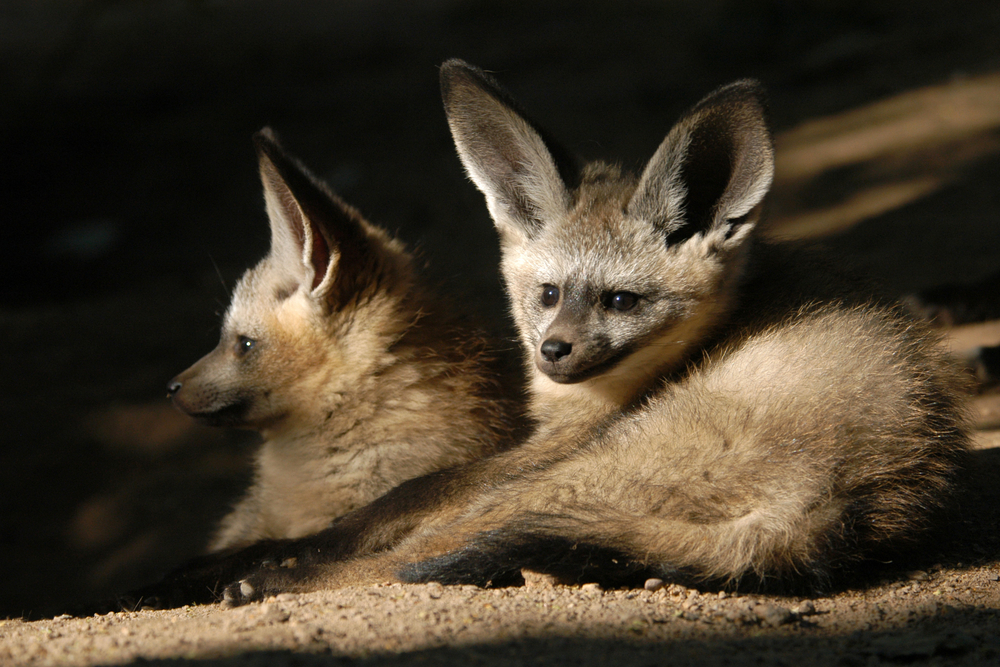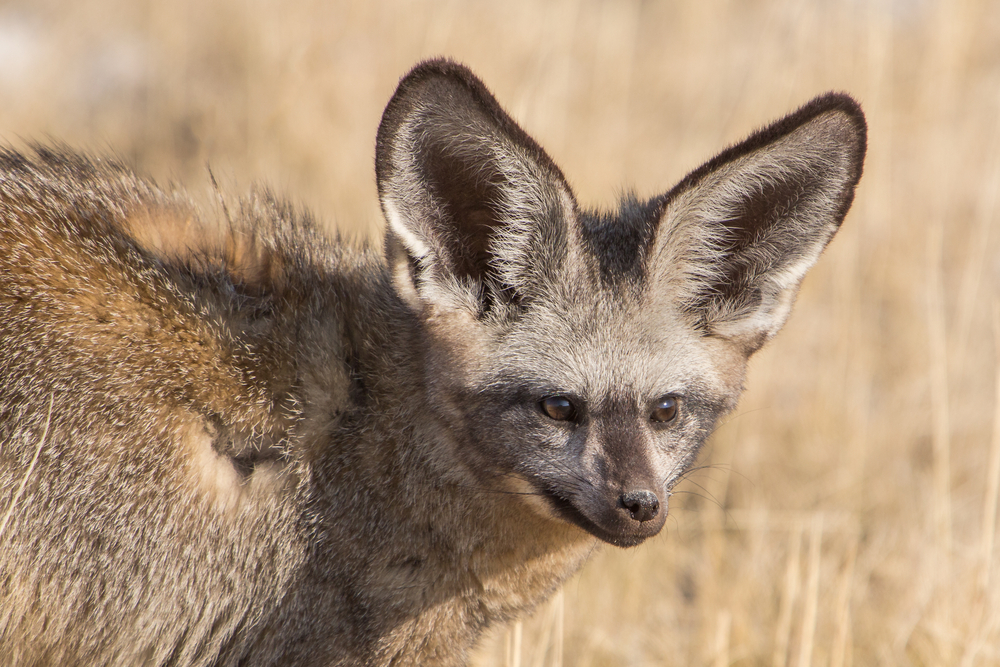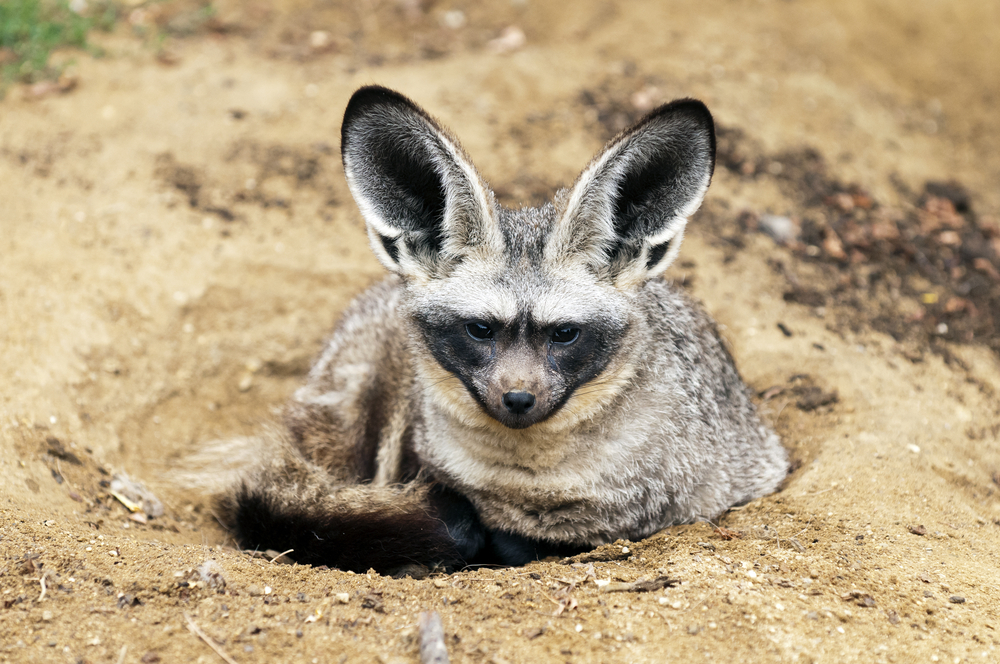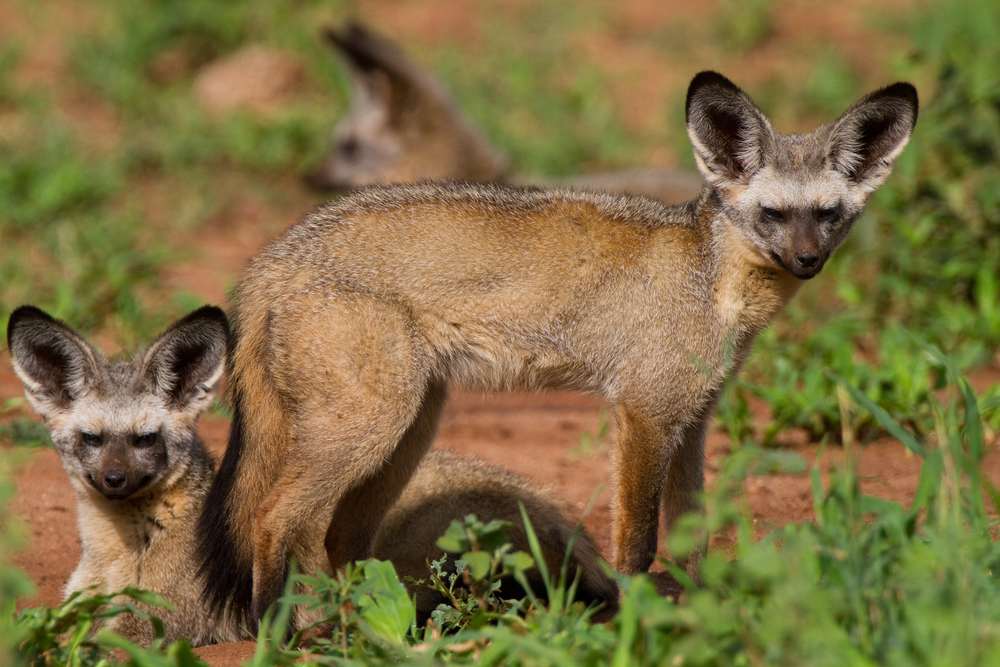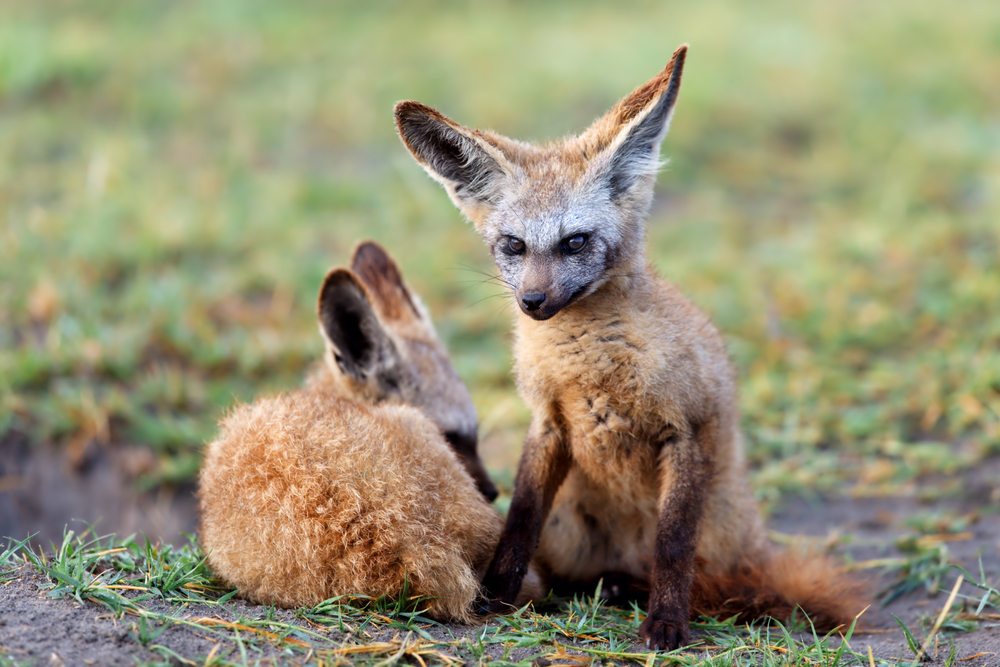About
The Bat-eared Fox, scientifically known as Otocyon megalotis, is a unique and fascinating canid species native to the savannas and grasslands of Africa. Belonging to the family Canidae, which includes wolves, foxes, and domestic dogs, the Bat-eared Fox occupies a distinctive niche in the Animal Kingdom as a specialized insectivore and nocturnal hunter.
Appearance and Characteristics: Bat-eared Foxes are characterized by their large ears, which resemble those of bats, and their sandy-colored fur with a paler underside. They have slender bodies and relatively short legs, adapted for agile movements and swift pursuit of prey. Their ears serve not only for enhanced hearing but also for thermoregulation, helping dissipate excess body heat in the hot African climate.
Bat-eared Foxes are predominantly found in open grasslands and savannas across eastern and southern Africa, where they forage for insects, particularly termites, which make up the majority of their diet. They are primarily nocturnal, spending the daylight hours resting in underground burrows to avoid the heat of the sun. Bat-eared Foxes are highly social animals, living in family groups consisting of a breeding pair and their offspring.
The diet of Bat-eared Foxes primarily consists of insects, particularly termites, which they locate using their acute sense of hearing. They use their sharp claws to excavate termite mounds or dig for other ground-dwelling invertebrates. Despite their name, Bat-eared Foxes do not consume bats but are instead specialized insectivores, playing a crucial role in controlling insect populations in their ecosystem.
Conservation Status
The conservation status of the Bat-eared Fox is currently of least concern according to the International Union for Conservation of Nature (IUCN) Red List. Although specific population data is lacking, Bat-eared Foxes are relatively widespread and adaptable, with no major threats to their survival identified. However, habitat loss and fragmentation due to human activities, such as agriculture and urbanization, could pose future challenges for this species, highlighting the importance of continued monitoring and conservation efforts to ensure their long-term viability in the wild.
Physical Characteristics
The Bat-eared Fox (Otocyon megalotis) is a small canid species notable for its distinctive physical features, well-suited to its arid savanna habitat:
Size and Weight:
- Length: Bat-eared foxes typically measure around 18 to 26 inches (46 to 66 centimeters) in body length.
- Height: They stand approximately 13 to 16 inches (33 to 41 centimeters) tall at the shoulder.
- Weight: Adult bat-eared foxes weigh between 7 to 12 pounds (3.2 to 5.4 kilograms), with males typically larger than females.
Physical Characteristics:
- Large Ears: As their name suggests, bat-eared foxes have oversized ears, measuring up to 5.5 inches (14 centimeters) in length. These ears are highly sensitive and help them detect the faint sounds of insect prey underground.
- Grayish Fur: Their fur is short and grayish-brown in color, with lighter underparts. This coloration provides effective camouflage against the sandy soil of their habitat.
- Slender Body: Bat-eared foxes have a slender build with long legs, enabling them to move swiftly across the open plains in search of food.
- Specialized Teeth: Their teeth are adapted for a diet primarily consisting of insects, with numerous small, pointed teeth and specialized molars for crushing hard insect exoskeletons.
- Diurnal Behavior: Unlike many other fox species, bat-eared foxes are primarily active during the day, or diurnal, to coincide with the activity of their insect prey.
These unique physical characteristics allow bat-eared foxes to thrive in their semi-arid grassland and savanna habitats, where they play a vital role in controlling insect populations.
Reproduction
The reproductive cycle of the Bat-Eared Fox, a small carnivore found in Africa, follows a pattern influenced by environmental factors and social dynamics within the pack. Here’s an overview:
Breeding Season: Bat-eared foxes typically breed during the wet season, which varies depending on their geographic location. Breeding often occurs from October to February in southern Africa.
Mating Behavior: During the breeding season, male Bat-Eared Foxes become more aggressive and territorial, competing for access to females. Mating pairs engage in courtship behaviors such as vocalizations, grooming, and scent marking.
Mating and Fertilization: Once a mating pair forms, copulation takes place, typically lasting several minutes. Female Bat-Eared Foxes have induced ovulation, meaning they release eggs in response to mating. Fertilization occurs internally.
Gestation: After successful mating, the female undergoes a gestation period of approximately 60 to 75 days, depending on environmental conditions and individual health.
Birth and Litter Size: Bat-eared foxes typically give birth to litters of 2 to 6 pups, although litter size can vary based on factors such as food availability and maternal condition. Births usually occur in burrows dug by the parents.
Maternal Care: Both parents play active roles in caring for the newborn pups. The mother nurses the pups with milk rich in nutrients, while the father assists in providing food and protection for the family.
Development and Weaning: Bat-eared Fox pups are born blind and helpless, relying entirely on their parents for nourishment and warmth. They begin to open their eyes after about 10 days and start to explore their surroundings. Weaning typically occurs around 8 to 10 weeks of age, after which the pups start to consume solid food.
Juvenile Stage: As the pups grow, they become more independent and gradually learn essential survival skills from their parents. They practice hunting techniques and social behaviors within the family unit.
Sexual Maturity: Bat-eared foxes reach sexual maturity at around 9 to 10 months of age. However, they may delay breeding until the following year, depending on environmental conditions and social dynamics within the pack.
Population Dynamics: The reproductive success of Bat-Eared Foxes is influenced by factors such as food availability, habitat quality, and predation pressure. Conservation efforts focus on protecting their natural habitats and minimizing human disturbances to ensure the sustainability of their populations.
Lifespan
The bat-eared fox, native to the African savannas, is known for its distinctive large ears and insectivorous diet. These foxes play a crucial role in controlling insect populations and are highly adapted to their arid habitats. Here’s an overview of the bat-eared fox’s lifespan and the threats it faces:
Wild Lifespan: In the wild, bat-eared foxes typically live for about 5 to 8 years. However, factors such as predation, disease, and food availability can influence their lifespan. Harsh environmental conditions and competition for resources also impact their survival rates.
Lifespan in Captivity: In captivity, bat-eared foxes may live longer than their wild counterparts. With access to consistent food, veterinary care, and protection from predators, captive individuals can live up to 10 years or more. However, their lifespan in captivity can still be affected by factors such as stress and genetic predispositions.
Threats to Bat-Eared Foxes:
- Predation: Bat-eared foxes are preyed upon by larger carnivores such as lions, leopards, hyenas, and African wild dogs. Predation rates may be higher for young foxes and individuals weakened by disease or injury.
- Habitat Loss and Fragmentation: Habitat loss due to agricultural expansion, urbanization, and infrastructure development threatens bat-eared fox populations. Fragmentation of their natural habitat reduces available foraging areas and increases the risk of human-wildlife conflict.
- Disease and Parasites: Infectious diseases and parasitic infections can affect bat-eared fox health and reproductive success. Diseases such as rabies, canine distemper, and tick-borne illnesses pose significant threats to their populations.
- Human-Wildlife Conflict: Bat-eared foxes may come into conflict with humans over resources such as livestock and crops. In some regions, they may be perceived as pests and targeted for control measures, including trapping and poisoning.
- Climate Change: Climate variability and changes in precipitation patterns can impact the availability of food resources for bat-eared foxes. Droughts and fluctuations in insect populations may affect their foraging success and reproductive rates.
Conservation efforts focused on habitat protection, sustainable land management, disease monitoring, and community engagement are essential for conserving bat-eared fox populations and ensuring their continued survival in their native habitats.
Eating Habits
The bat-eared fox is a small carnivorous mammal found in the savannas and grasslands of eastern and southern Africa. It is named for its distinctive large ears, which resemble those of a bat. With specialized adaptations for hunting insects, the bat-eared fox has unique eating habits suited to its diet and habitat.
Diet: The primary diet of the bat-eared fox consists of insects, particularly termites. Termites make up a significant portion of their diet, especially during the wet season when termite populations are abundant. They also consume other insects such as beetles, ants, grasshoppers, and scorpions. Occasionally, they may supplement their diet with small vertebrates like rodents, birds, and eggs.
Foraging Technique: Bat-eared foxes are nocturnal hunters, and they rely heavily on their keen sense of hearing to detect the sounds of insect activity underground. Using their large ears, they listen for the movements of subterranean insects like termites and then dig them out using their specialized claws and teeth. They are adept diggers and can excavate termite mounds or burrow into the ground to access their prey.
Hunting Strategy: When hunting insects, bat-eared foxes often work cooperatively in pairs or family groups. They may coordinate their efforts to surround a termite mound or dig simultaneously in search of insects. Their sharp teeth and strong jaws allow them to crush the tough exoskeletons of insects and extract the nutrient-rich contents.
Seasonal Variation: The diet of bat-eared foxes may vary seasonally based on the availability of prey. During the dry season when insect populations decline, they may rely more heavily on small vertebrates and plant matter to sustain themselves. However, termites remain a staple food source throughout the year, even during periods of scarcity.
Role in Ecosystem: As insectivores, bat-eared foxes play a crucial role in controlling insect populations, particularly termites, which can be agricultural pests. By consuming large numbers of insects, they help regulate ecosystem dynamics and contribute to the balance of savanna ecosystems.
Conclusion: The bat-eared fox exhibits specialized adaptations for hunting insects, with a diet primarily consisting of termites and other invertebrates. Their nocturnal habits, keen sense of hearing, and digging prowess make them efficient predators in their grassland habitat. Through their feeding habits, bat-eared foxes contribute to the health and functioning of savanna ecosystems.
Uniqueness
The Bat-eared Fox is a distinctive and intriguing small mammal native to the African savanna. Known for its oversized ears and sociable nature, this fox stands out for several unique characteristics that are well-adapted to its environment. Here are some key aspects that make the Bat-eared Fox unique:
Oversized Ears: The most striking feature of the Bat-eared Fox is its large, bat-like ears, which can be as long as 5 inches. These ears are not just for show; they serve to dissipate heat and help the fox stay cool in the hot savanna climate. Additionally, they are highly sensitive and help the fox detect insects and small animals underground, making them effective hunters.
Insectivorous Diet: Unlike many other fox species that are omnivorous, the Bat-eared Fox primarily feeds on insects. Termites and ants make up a large part of their diet, but they also eat other insects, larvae, and the occasional small rodent or bird. This diet is facilitated by their unique dentition; they have more teeth than most mammals, which are small and shaped to help them chew insects efficiently.
Nocturnal and Crepuscular: Bat-eared Foxes are primarily active during the night and twilight hours, which helps them avoid the heat of the day. This behavior also coincides with the activity patterns of their main prey, termites and ants.
Social and Family-Oriented: These foxes are known for their social structure, often seen in pairs or small family groups. They exhibit a high degree of social interaction, including mutual grooming and play. The males are particularly involved in raising the young, which is somewhat uncommon among canids.
Burrowing Habits: Bat-eared Foxes use burrows both for protection from predators and as a way to control their body temperature. They either dig these burrows themselves or take over abandoned burrows of other animals. These burrows are crucial for their survival, especially for raising pups.
Adaptability: Despite their specialized diet, Bat-eared Foxes are adaptable to different savanna environments, ranging from arid areas to more vegetated regions. They adjust their foraging habits and territories based on food availability and environmental conditions.
Conservation Status: While not currently at high risk, Bat-eared Foxes are vulnerable to habitat loss due to agricultural expansion and human settlement. Their role in controlling insect populations makes them beneficial to their ecosystem, highlighting the importance of their conservation.
The unique combination of physical adaptations, dietary preferences, and social behaviors makes the Bat-eared Fox a fascinating example of evolutionary specialization and an important component of the biodiversity in African savannas.
Related Family Species
Sources
- Britannica, Bat-Eared Fox, https://www.britannica.com/animal/bat-eared-fox, retrieved November 2023.
- Burnie, David & Wilson, Don, Animal, Smithsonian Institute, Washington DC.
- Hickman et al, Integrated Principle of Zoology, McGraw Hill, Boston.



































































